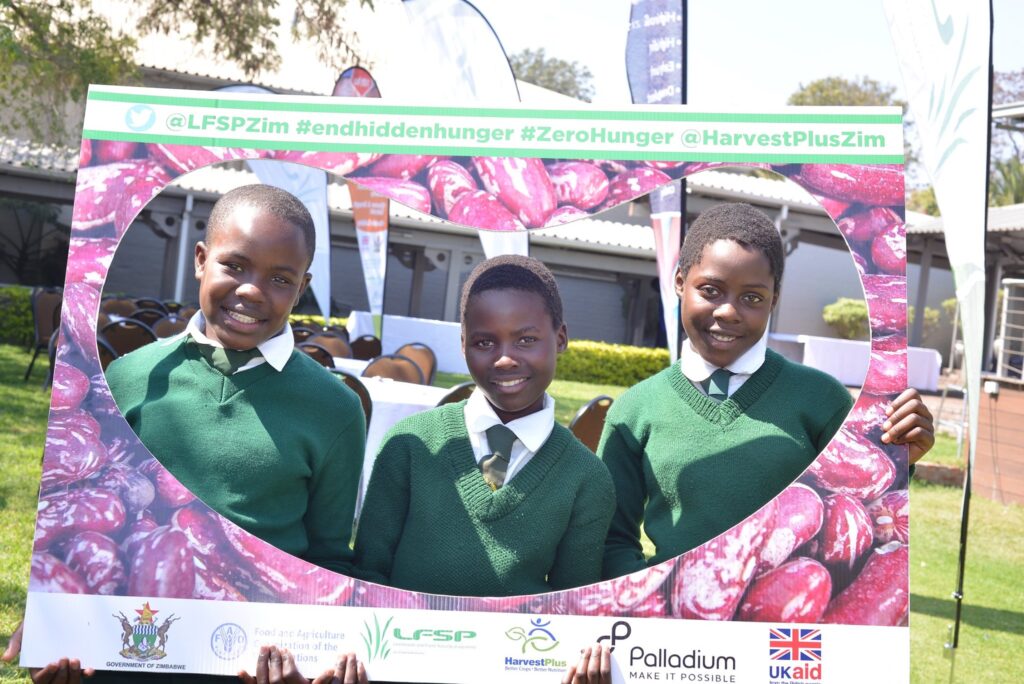“While gains have been made since 2000, more must be done to tackle malnutrition in all its forms—including the hidden hunger of micronutrient deficiency.”
Annabel Gerry, head of the UK Department of International Development in Zimbabwe and South Africa, spoke to a sympathetic crowd. The 250 attendees, ranging from scientists and economists to ministry officials and seed company representatives gathered in Harare in August to learn about the country’s experience in scaling and promoting crop biofortification.
The strategy involves enhancing the micronutrient content of regularly consumed staple crops like maize and beans using conventional plant breeding methods generates measurable improvement in nutrition and health.
“The role of families is also critical,” Gerry said. “They choose the food that will help their children best grow.”
The learning event was jointly organized by HarvestPlus Zimbabwe and the Food and Agriculture Organization (FAO)’s Southern Africa Regional Office. HarvestPlus is a strategic technical partner on biofortification in the Livelihoods and Food Security Programme (LFSP), managed by FAO and funded by the UK Aid Department for International Development (DFID). The LFSP aims to contribute to poverty reduction through increased agricultural productivity, increased incomes, and improved food and nutrition security for smallholder farmers.
The event stressed connecting agriculture and nutrition—by producing quality food that could help address malnutrition.
“This intervention is critical in complementing other approaches being implemented in Zimbabwe to prevent and correct micronutrient malnutrition amongst the poor and vulnerable rural communities,” said Dr. Agnes Mahomva, permanent secretary of the ministry of health and child care. In 2015, her ministry launched a national food fortification strategy aimed at preventing and controlling micronutrient deficiency—and included biofortification as a key solution.
Sustaining the impact of biofortification requires not only continued collaboration to research, develop and grow the crops, but also a supportive policy framework. Deputy Minister of Lands, Agriculture, Water, Climate and Rural Resettlement, Honorable Vangelis Haritatos also highlighted the critical role that agriculture plays in feeding and nourishing the nation.
“This event has come at an appropriate time when my ministry has put in place a National Agriculture Policy Framework (NAPF) 2019–2030, to guide the sector in line with encouraging investment into agriculture that ensures wealth creation and food security,” said Haritatos. “One of the pillars under the framework will be driving the food and nutrition security and resilience issues for which biofortification will be top on the agenda.”
Ambassador Mary Mubi, Senior Principal Director in the Office of the President, drew a distinction between filling bellies and ensuring bodies are nourished with essential vitamins and minerals. Deficiencies in such micronutrients can lead to a devastating array of problems, including blindness, stunted cognitive and physical development, diarrheal and respiratory infections, and even death.
“Our agriculture sector has been long criticized for its preoccupation on feeding the nation and filling people’s stomachs without necessarily nourishing them, with national food security being interpreted by many as cereal adequacy for the majority of the population,” she said. “Our programs and efforts have supported and ensured that people have adequate access to white maize with little consideration of access to key micronutrients needed for growth and development.”
Exhibitions gave attendees the chance to interact with farmers , nongovernmental organizations, and companies driving biofortification’s uptake—including the Campaign for Female Education, who won gold at the 2019 Chelsea Flower Show for a garden including biofortified crops.
“Vitamin A orange maize is the best, we now have better health,” said Joice Jacob a smallholder farmer from Mashonaland, Central Province.
To date a cumulative 259 MT of vitamin A maize seed and 400 MT of iron bean seed have been distributed in the country through a combination of direct distribution and market led interventions. By end of 2018, an estimated 48,000 and another 120,000, smallholder farm households, were growing vitamin A orange maize and iron beans, respectively, in Zimbabwe.
“120 years ago, there was no white maize in Zimbabwe, said Dr. John MacRoberts, the managing director of Mukushi Seeds. “It was introduced and became popular so we can do the same with vitamin A orange maize.”
His company is part of the change, too—by producing and marketing two vitamin A maize varieties and one of iron beans.
